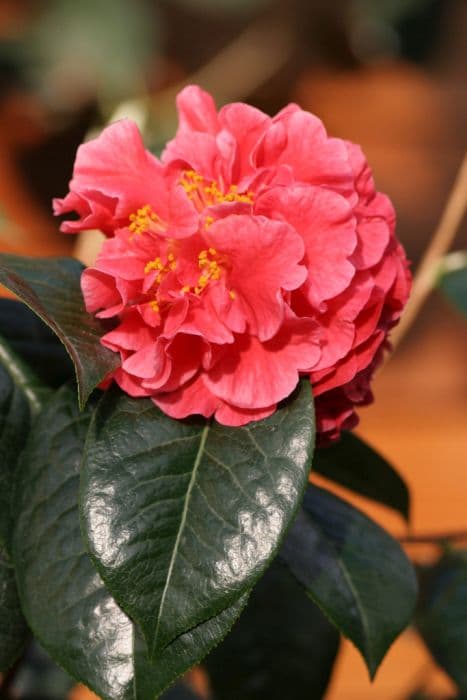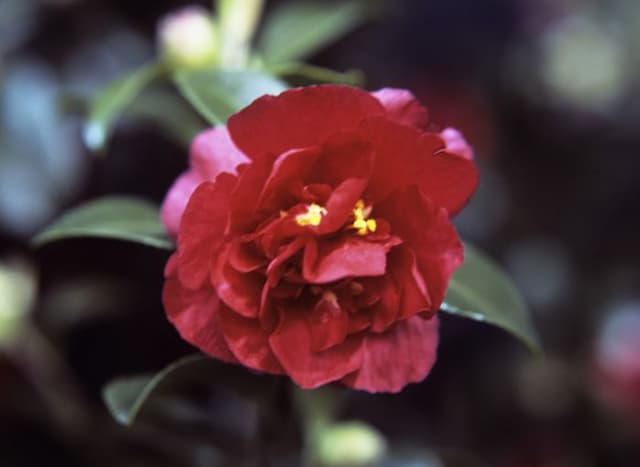Yuletide camellia Camellia × vernalis 'Yuletide'

ABOUT
'Yuletide' is a variety of Camellia that showcases a visually striking display during its blooming season, which often coincides with the holiday period, hence the festive name. The plant bears deep green, glossy leaves that present a lush, evergreen backdrop throughout the year. The leaves are typically oval-shaped with a slightly serrated edge, contributing to the plant's overall texture and visual density. The true showstoppers of 'Yuletide' are its flowers, which bloom prolifically in a vibrant red hue. These striking blossoms feature a classic Camellia shape, with layered petals that unfurl to reveal a formal, almost rose-like appearance. At the center of each flower, there is a cluster of conspicuous yellow stamens that add a lovely contrast to the red petals, accentuating the flower's appeal and drawing in pollinators. 'Yuletide' Camellia's blooms are known for their longevity, often adorning the plant for an extended period, which adds to the plant's value as a decorative choice. The overall impression of 'Yuletide' is one of enduring elegance and festive charm, making it a popular choice for gardeners looking to add a splash of vibrant color to their outdoor spaces during the cooler months when other plants may not be as showy.
About this plant
 Names
NamesFamily
Theaceae
Synonyms
Yuletide Camellia, Winter Blooming Camellia, Christmas Camellia
Common names
Camellia × vernalis 'Yuletide'.
 Toxicity
ToxicityTo humans
The Yuletide Camellia is not considered highly toxic to humans. In general, camellias are mostly non-toxic, but they can cause mild gastrointestinal upset if ingested in large quantities. Symptoms from ingesting parts of the plant might include nausea, vomiting, or diarrhea. However, adverse reactions are relatively rare, and this plant is mainly considered an irritation risk rather than a serious toxic threat to humans.
To pets
The Yuletide Camellia is also not considered highly toxic to pets such as dogs and cats. Similar to its effects on humans, if pets ingest parts of this plant, it could potentially lead to mild gastrointestinal upset, which could include symptoms such as vomiting or diarrhea. While it is not regarded as a seriously poisonous plant to pets, it is always advisable to prevent pets from eating plants to avoid any potential negative reactions.
 Characteristics
CharacteristicsLife cycle
Perennials
Foliage type
Evergreen
Color of leaves
Green
Flower color
Red
Height
8-10 feet (2.4-3.0 meters)
Spread
6-8 feet (1.8-2.4 meters)
Plant type
Shrub
Hardiness zones
7
Native area
Asia
Benefits
 General Benefits
General Benefits- Decorative Flowers: 'Yuletide' Camellias have vivid red blooms with bright yellow stamens that add a splash of color to gardens during the winter months.
- Evergreen Foliage: They provide year-round greenery, which is especially valuable in colder seasons when other plants may die back.
- Drought Tolerance: Once established, Camellias are quite drought-tolerant, reducing the need for frequent waterings.
- Shade Tolerance: These plants can thrive in partial shade, making them versatile for different lighting conditions in the landscape.
- Long Blooming Period: The 'Yuletide' variety has a longer blooming season than many other flowers, providing color and interest for an extended period.
- Low Maintenance: Camellias generally require minimal pruning and care, making them suitable for gardeners looking for low-maintenance options.
- Cold Resistance: They are relatively hardy against cold temperatures, which is beneficial for gardens in cooler climates.
- Attracts Pollinators: The flowers attract bees and other pollinators, supporting the local ecosystem.
- Landscape Versatility: These plants can be used as specimens, in borders, or as part of a foundation planting, offering design flexibility in landscaping projects.
- Privacy Screen: When planted in groups, 'Yuletide' Camellias can form a dense screen, providing privacy and reducing noise.
 Medical Properties
Medical PropertiesThis plant is not used for medical purposes.
 Air-purifying Qualities
Air-purifying QualitiesThis plant is not specifically known for air purifying qualities.
 Other Uses
Other Uses- Floral Arrangements: The vibrant red flowers of the Camellia 'Yuletide' can be cut and used in festive floral arrangements during the holiday season.
- Photography Prop: Its striking blooms are an excellent subject for photography, providing a natural and colorful backdrop.
- Educational Tool: It can be used in horticultural classes to teach about hybrid plants, crossbreeding, and plant propagation techniques.
- Holiday Gifts: Small potted Camellia 'Yuletide' plants can be given as living holiday gifts that last longer than cut flowers.
- Garden Contrast: Use its dark, glossy leaves and red flowers to create striking contrasts in garden designs or color-themed gardens.
- Festival Decorations: The flowers and branches can be incorporated into decorations for winter festivals or parades.
- Crafts: Dried petals or leaves can be used in crafting, for example, to make natural dyes or to include in handmade paper.
- Bonsai: Some enthusiasts may use Camellia 'Yuletide' for bonsai due to its interesting foliage and seasonal blossoms.
- Teaching Conservation: It can be a case study for preserving ornamental plant varieties and understanding their role in biodiversity.
- Winter Weddings: The 'Yuletide' camellia can be used to decorate venues or as part of the bridal bouquets in winter weddings for a touch of natural beauty.
Interesting Facts
 Feng Shui
Feng ShuiThe Camellia is not used in Feng Shui practice.
 Zodiac Sign Compitability
Zodiac Sign CompitabilityThe Camellia is not used in astrology practice.
 Plant Symbolism
Plant Symbolism- Adoration and Devotion: The camellia flower is often associated with deep admiration. The 'Yuletide' variety, with its bright red flowers, symbolizes the passionate and heartfelt adoration one might feel during the holiday season.
- Perfection and Excellence: Camellias are known for their perfect, symmetrical blooms. The 'Yuletide' camellia, with its showy flowers, represents the pursuit of perfection and the celebration of excellent beauty.
- Longevity: Camellias are evergreen and long-lived plants. Their resilience through the winter months, especially the 'Yuletide' variety that blooms around Christmas, symbolizes long-lasting life and enduring spirit.
- Love and Affection: The luxurious appearance of camellias, along with their association with the festive season, makes them a symbol of love and affection. Giving a 'Yuletide' camellia may express warm feelings and tender care.
- Pride: In some cultures, the camellia represents pride. The vibrant 'Yuletide' variant, with its striking red flowers against dark green leaves, can be given to celebrate someone's achievements or personal pride.
 Water
WaterFor the 'Yuletide' camellia, ensure the soil is kept consistently moist but not waterlogged. This generally means watering once a week, but you must adjust based on temperature and soil drainage. During hot, dry periods, increased watering frequency may be necessary. Aim for 1 to 1.5 gallons of water each time you water for an established plant in a garden setting. It's advisable to water deeply and infrequently rather than shallow and frequent watering to encourage deep root growth.
 Light
Light'Yuletide' camellias flourish in partial shade with filtered sunlight. They are best situated in a spot that is protected from the intense afternoon sun which can scorch their leaves. Morning sunlight with afternoon shade or dappled sunlight throughout the day is ideal for these plants.
 Temperature
Temperature'Yuletide' camellias prefer moderate climates and can usually handle temperatures ranging from 20 to 90 degrees Fahrenheit. They thrive best in a range of 68 to 85 degrees Fahrenheit and should be protected from harsh winter winds and extremely high summer temperatures.
 Pruning
PruningPrune 'Yuletide' camellias to maintain shape and promote bushier growth, typically just after they finish flowering in late winter or early spring. Remove dead or weak wood, and thin out dense areas to improve air circulation. Pruning at this time allows for the setting of buds for the next season's blooms.
 Cleaning
CleaningAs needed
 Soil
SoilThe Yuletide Camellia thrives best in well-draining, acidic soil with a pH between 5.5 and 6.5. A soil mix composed of equal parts organic matter, such as leaf mold or compost, and coarse material like pine bark or perlite, is ideal. Regularly amending the soil to maintain its structure and acidity levels will benefit the plant's health and blooming.
 Repotting
RepottingYuletide Camellias should be repotted every 2-3 years, or when they become root-bound. The best time to repot these camellias is after they've finished blooming, usually in late winter or early spring, utilizing an acidic, well-draining soil mix to prevent root rot.
 Humidity & Misting
Humidity & MistingYuletide Camellias prefer moderate to high humidity levels. Aim for a humidity level between 40% and 60% for optimal growth. If indoor air is too dry, especially during winter, using a humidifier or placing the pot on a pebble tray filled with water can help achieve the desired humidity.
 Suitable locations
Suitable locationsIndoor
Provide bright, indirect light and maintain humidity.
Outdoor
Plant in partial shade, shelter from strong winds, mulch well.
Hardiness zone
7-9 USDA
 Life cycle
Life cycleThe Yuletide Camellia starts its life cycle when seeds germinate, typically requiring warm conditions. Seedlings develop into juvenile plants, characterized by the growth of glossy, dark green leaves and a sturdy stem. As the plant matures, it enters the vegetative stage, where it grows and develops its structure, often over several years, before it reaches maturity and is capable of flowering. The reproductive phase begins with the production of vibrant red flowers, usually around the winter holiday season, hence the name 'Yuletide.' These flowers can attract pollinators, although many Camellia varieties can self-pollinate. After pollination and fertilization, seed pods develop, eventually releasing seeds to start a new life cycle, while the parent plant may continue to grow and bloom annually for many years.
 Propogation
PropogationPropogation time
Fall-Winter
The Camellia × vernalis 'Yuletide', commonly known as the Yuletide Camellia, can be propagated effectively through semi-hardwood cuttings taken during the summer months when the plant's growth begins to slow and the new stems start to firm up. To propagate Yuletide Camellia using this method, a cutting of about 4 to 6 inches (10 to 15 centimeters) is taken from a healthy parent plant, ideally from a branch where the current year's growth is beginning to mature. The bottom inch (2.54 centimeters) of the cutting should be stripped of leaves, and the cut end can be dipped into a rooting hormone to encourage root development. The prepared cutting is then placed in a pot containing a mix of peat and perlite or a similar well-draining rooting medium. It must be kept in a humid environment with a consistent temperature and out of direct sunlight until roots have formed and the cutting is ready to be potted up into a larger container or planted directly in the garden.









